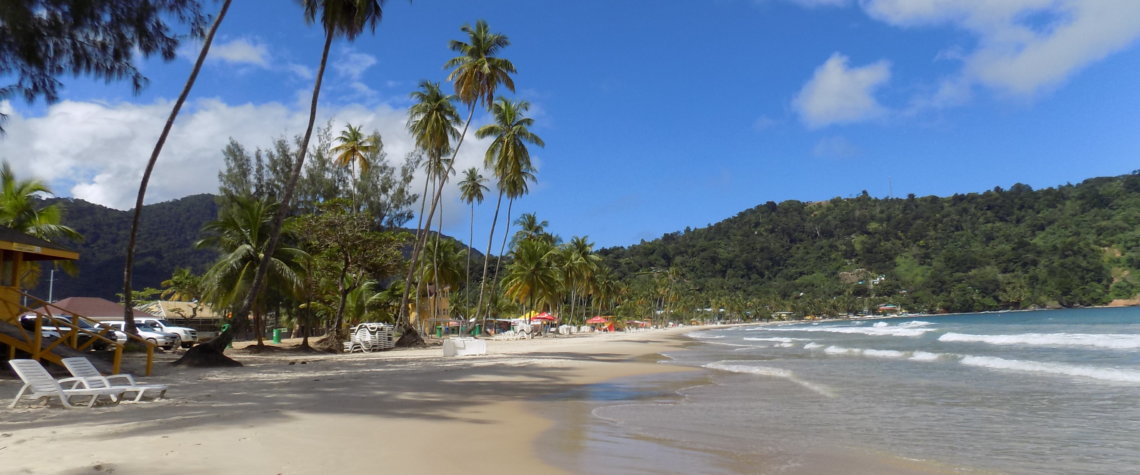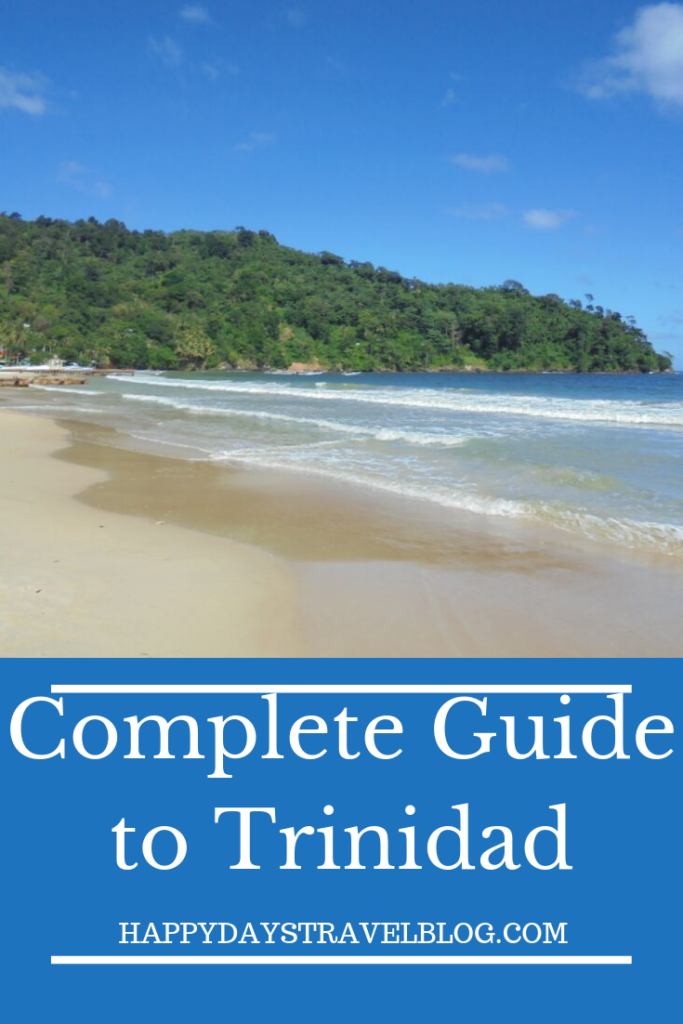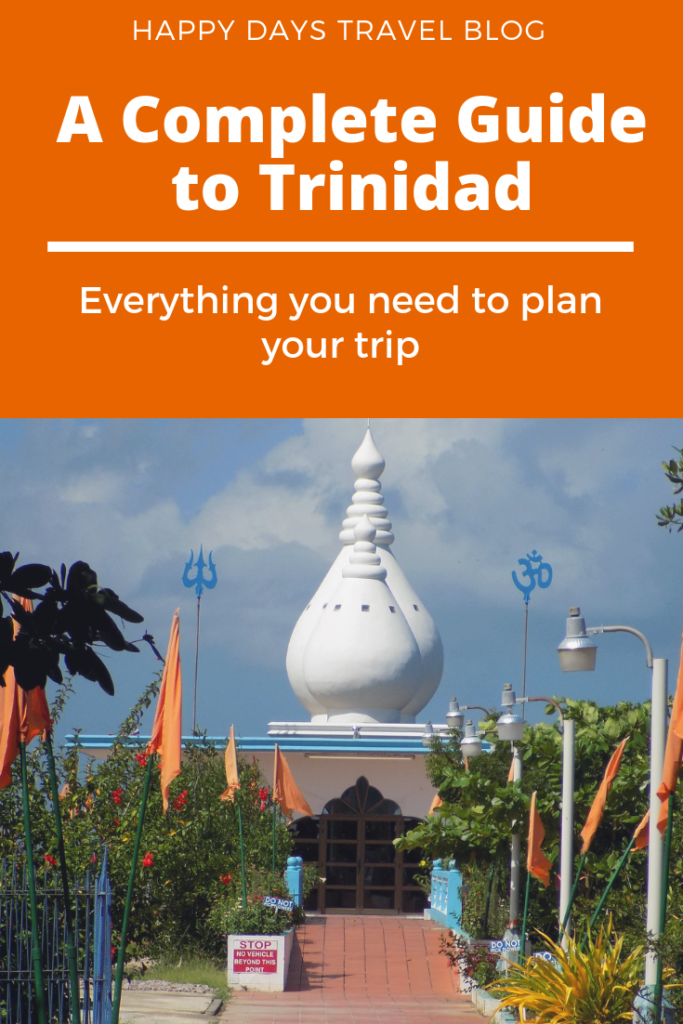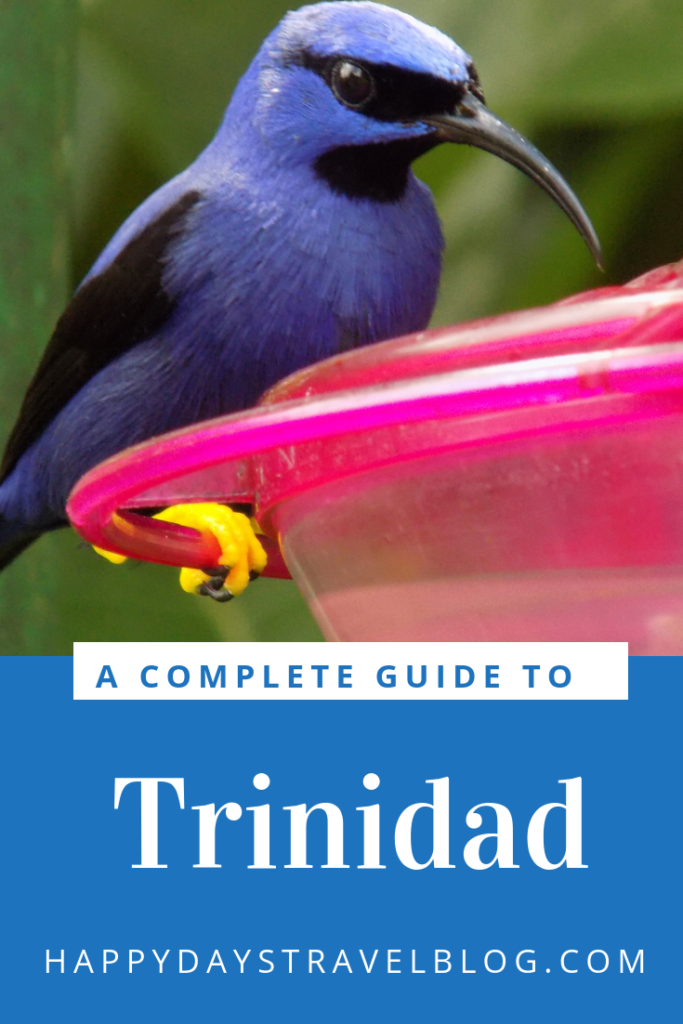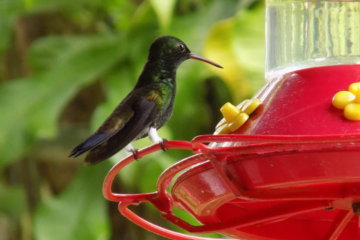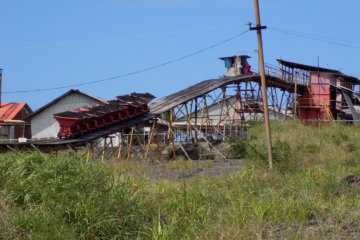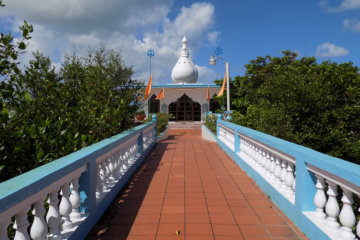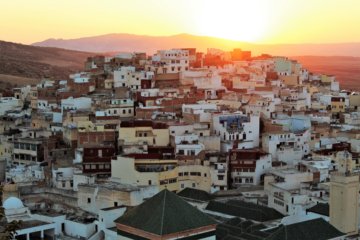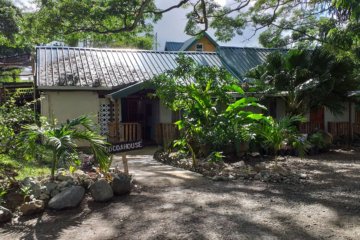Welcome to my Trinidad travel guide! In this article, you will find all the information you will need if you are planning a trip to this Caribbean island.
In this article
First Thoughts
Trinidad is the larger and more populous of the two major islands of Trinidad and Tobago. Mention the words ‘Caribbean island’ and the image conjured up for most people is of palm-fringed, white-sand beaches and gloriously clear azure-blue sea. Whilst Trinidad does have a number of places to swim and sunbathe, this is not its main attraction. Being an oil-rich island with a stable economy, Trinidad is far less reliant on tourism than other destinations in the Caribbean.
For the visitor, this manifests itself in a lack of information, signage and infrastructure directed at tourists. In some ways, this makes a refreshing change. When travelling around the island, you get to experience it like a local. It can also be frustrating, however. We spent a lot of time looking for places we’d read about, only to get there and find the attraction closed for the day or, even, permanently shut down.
Having said this, though, Trinidad is an amazing place with friendly people, good food and great music. I would definitely recommend a visit!
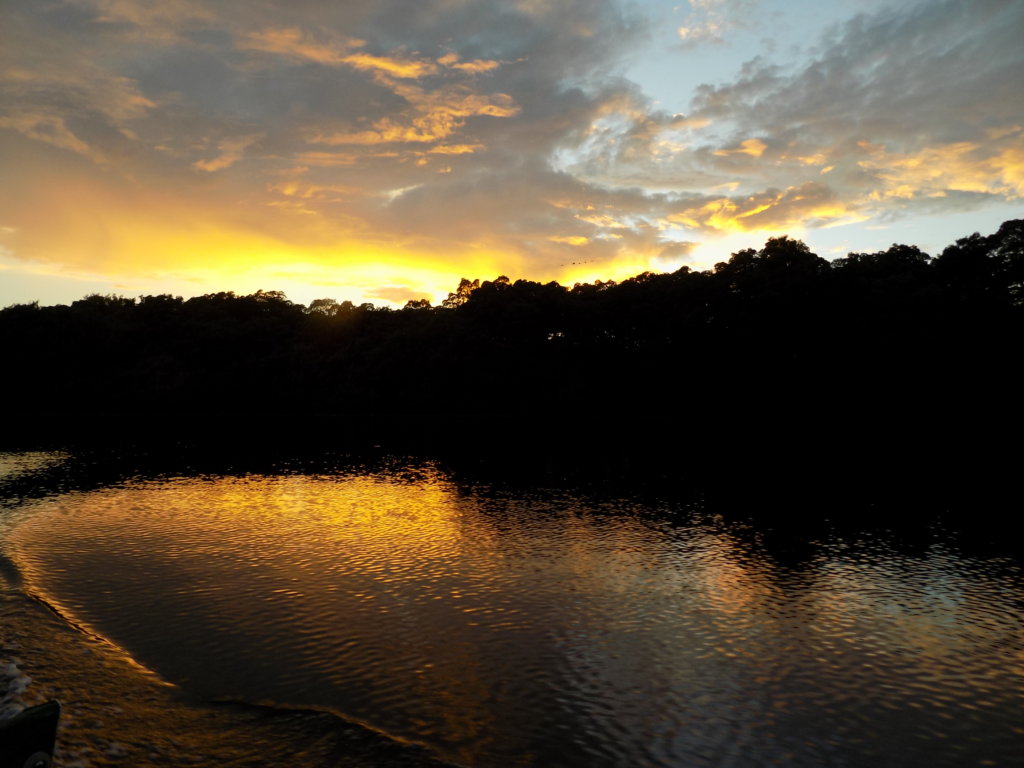
Essential Information About Trinidad
- Area – 4,748 square kilometres
- Population – c 1.3 million
- Language – English
- Capital – Port of Spain
- Currency – Trinidad and Tobago Dollar (TTD)
- Time zone – GMT -4
- Telephone – the country code for Trinidad is 868.
- Electrical socket – standard voltage of 115V with type A and B sockets (two flat pins or two flat pins with a third round earth pin). If you are travelling from the US, you won’t need an adaptor, but if you’re coming from the UK or elsewhere, you will. Why not take a universal travel adapter with you.
- Visas – visitors from most countries, including the UK and USA, do NOT need a visa to visit Trinidad. Your passport must be valid for at least six months from the date of entry to the country. You will be given the right to remain for ninety days. You may be asked to show your return air ticket and proof of sufficient funds to pay for your stay.
Local laws
Drug traffickers face severe penalties. Marijuana is illegal.
Same-sex relationships are still illegal in Trinidad. Legislation exists that bars LGBT people from entering the country. In reality, this is rarely enforced and there is growing local support for LGBT rights, but it’s still best to avoid public displays of affection.
It is an offence for anyone, including children, to wear or carry camouflage clothing.
Health and Safety in Trinidad
Health
It’s important to check the latest health advice issued by your government before you travel. In the UK, this is available from the National Travel Health Network and Centre (NaTHNaC).
In some areas of Trinidad, medical facilities may be limited. The main hospital in Port of Spain, as well as several private clinics, is able to treat most problems, but medical evacuation to Miami or elsewhere may be necessary in more serious cases. Make sure you have adequate travel health insurance. For UK nationals, the Caribbean is excluded from most general policies, so you need to buy extra cover.
There is a risk of Zika virus transmission in Trinidad. Also, mosquito-borne dengue fever is endemic. The best line of defence is not to get bitten!
- Use a DEET based insect repellent
- Wear mosquito repellent bracelets
- Burn mosquito coils
- Cover up, especially at dawn and dusk
- Eat Marmite! This is Mark’s preferred method!
If you need medical assistance whilst in Trinidad, dial 811.
Safety
The vast majority of tourist visits to Trinidad are incident-free. However, it is sensible to consider the following:
Crime
There’s a high level of gang-related violent crime in Trinidad, especially in certain neighbourhoods in Port of Spain – Laventille, Morvant and Barataria. Whilst these crimes generally involve only local people, these areas are best avoided, particularly after dark.
Opportunist theft, especially during festivals and carnival season, is common. Take the same precautions as you would take anywhere:
- Don’t carry large amounts of cash
- Don’t wear ostentatious jewellery
- Use a hotel safe where possible to store valuables and passports
- Wear a money belt
- Don’t walk in deserted areas, even during daylight
- Take care when withdrawing cash from an ATM
Driving
Whilst hiring a car is the best way to get around Trinidad, you will experience erratic driving practices and dreadful road conditions, so you need to be extra vigilant. The Churchill Roosevelt Highway to and from Piarco International Airport is a notorious accident blackspot with boy racers using it as a racetrack.
Always drive with the doors locked.
Taxis
Always use licensed vehicles, identified by registration plates beginning with H (for hire). Some cars and minibuses with P registration plates offer taxi services, but these are private vehicles and should be avoided.
Terrorism
The threat of terrorist attack in Trinidad is quite high with crowded places likely to be targeted. Over 100 Trinidadians are known to have travelled to Syria and Iraq to fight with the Daesh terrorist group. Some of these people were arrested on their return to Trinidad in early 2018 as it was thought they were planning attacks during carnival. The government of Trinidad and Tobago has a robust counter-terrorism strategy and co-operates with international governments to reduce the risk.
Visitors should check with their government’s most up-to-date travel guidelines, but shouldn’t be put off travelling to Trinidad.
Emergency numbers
- Fire and ambulance – 990
- Police – 999
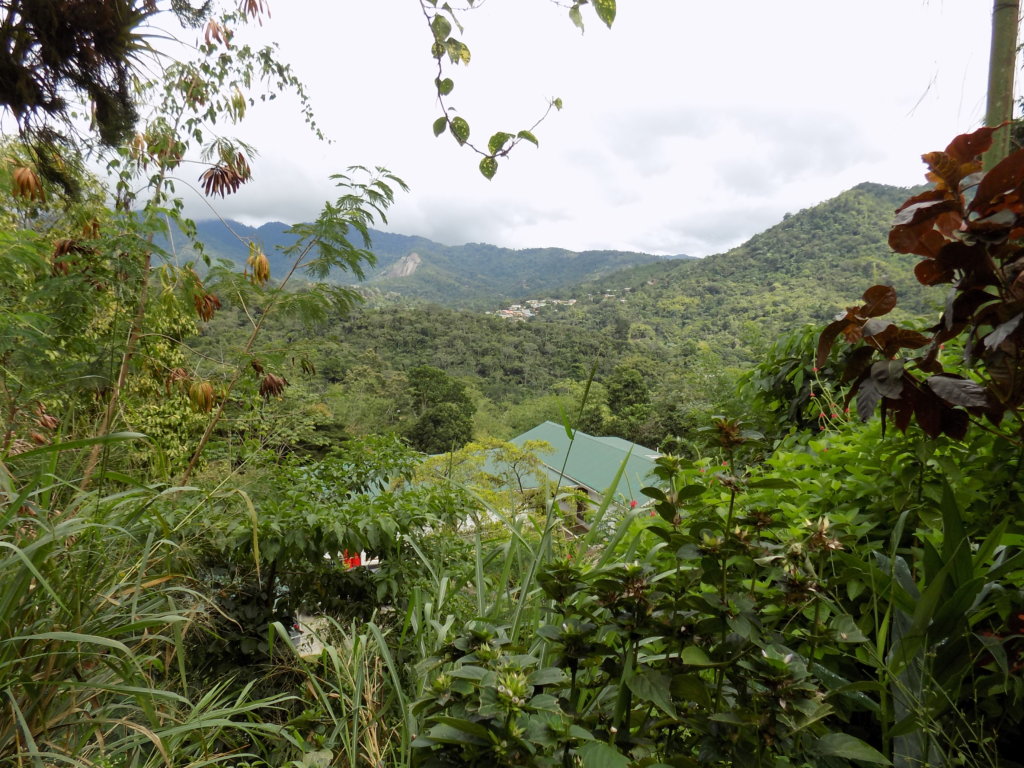
Festivals and Celebrations in Trinidad
Public Holidays
Trinidad’s 17 annual public holidays reflect the country’s ethnic and cultural diversity with Christian, Hindu and Muslim celebrations included. Banks and workplaces close, concerts are organised, shops have sales, and families get together to eat, drink and socialise.
- January 1 – New Year’s Day
- March 30 – Shouter Baptist Liberation Day – a relatively new public holiday in recognition of the African-based religion that suffered persecution in colonial Trinidad.
- February/March – Monday, Tuesday and Ash Wednesday before Lent – Carnival. This is Trinidad’s most famous festival with fetes, pan and calypso competitions and costumed street processions.
- March/April – Good Friday and Easter Monday – as well as attending church and baking hot cross buns, Trinidadians indulge in the ‘beating of the bobolee’. This involves pummelling an effigy of Judas Iscariot or, more usually these days, of any politician or public figure who’s thought to deserve it. Easter weekend also sees a colourful kite festival at the Savannah in Port of Spain.
- May 30 – Indian Arrival Day – commemorating the arrival in 1845 of the first indentured Indian labourers to Trinidad.
- June 10 – Corpus Christi – a Catholic holiday marked by processions in many island villages.
- June 19 – Labour Day – a public holiday in recognition of trade unions and workers. It is most publicly celebrated in Fyzabad, southern Trinidad, where the powerful Oil Workers’ Union was established.
- August 1 – Emancipation Day – commemorating the abolition of slavery in 1834. There is a procession through Port of Spain.
- August 31 – Independence Day – celebrating the 1962 independence from the UK.
- August/September – Eid-ul Fitr
- September 24 – Republic Day
- September/October – Divali -a festival honouring Mother Lakshmi, the Hindu goddess of light.
- December 25 – Christmas Day
- December 26 – Boxing Day
Other Celebrations in Trinidad
- Phagwah – celebrated in March or early April to honour the Indian tradition of Holi. It is best experienced in central Trinidad. It isn’t a public holiday, but many Trinis of all backgrounds take part.
- Turtle Season – the leatherback laying season officially opens on March 1st with guided viewing sessions at Grande Riviere.
- La Divina Pastora – held on the third Sunday after Easter in Siparia in southern Trinidad. A statue of the Black Virgin is carried in a procession through the town and locals, dressed in new clothes, celebrate with feasting and drinking.
- Pan in the 21st Century – steel band competition held every April in Port of Spain.
- Santa Rosa Festival – held in the last week in August in Arima, Trinidad. It celebrates the culture and traditions of indigenous Amerindians with musical and acrobatic performances and street parties.
- Trinidad and Tobago Film Festival – held over two weeks in September with films from all over the Caribbean, plus arthouse cinema from around the world.
- San Fernando Jazz Festival – takes place over two days in late September on San Fernando Hill, Trinidad.
- Steel Pan Jazz Festival – a series of concerts and workshops held at the beginning of October each year in Port of Spain. It features a fusion of foreign jazz masters and the best Trini steel bands.
- Taste – a culinary festival which takes place in Port of Spain every October with cooking demonstrations, rum, wine and food tastings, and live music.
- Hosay – an Islamic festival commemorating the martyrdom of Mohammed’s grandsons. Hussein and Hassan, during the Holy War in Persia. It is marked by four days of night parades which goon to the early hours.
- Parang Season – taking place in December, this is a tradition of nativity songs sung in Spanish with a mixture of French patois dating from colonial days. Parang groups perform in bars, clubs and door-to-door.
Best Time to Go to Trinidad
Trinidad is a year-round destination with temperatures ranging from 21 to 32 degrees centigrade every day. In this tropical climate, rain is possible at any time, although the wet season is generally thought to run from the end of May to November.
Most visitors go to the island between December and March. At this time, the magic of carnival is everywhere, the trees are in full bloom and the weather is at its most forgiving with long hours of sunshine, very little rain and cool nights.
Accommodation and flight prices are pretty consistent throughout the year, though there is an inevitable price hike during Carnival week.
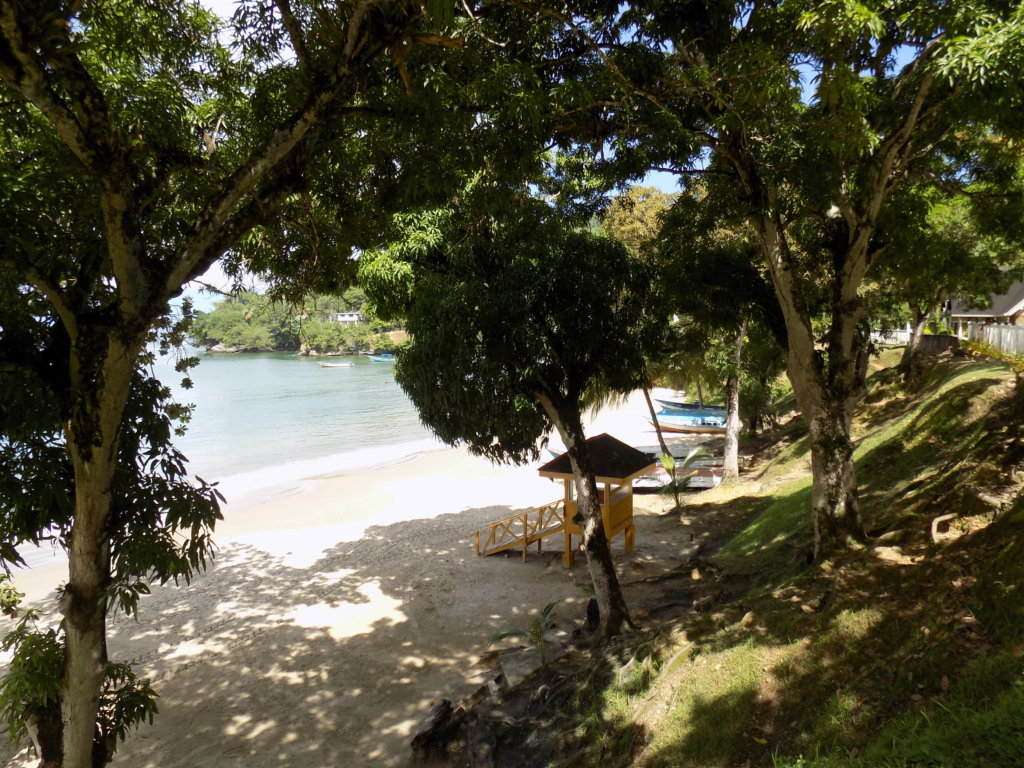
What to Pack for Trinidad
With its tropical climate and consistently warm temperatures, unless you are someone who particularly feels the cold, you are unlikely to need jumpers and jackets when visiting Trinidad. You’ll definitely need sunglasses and a sunhat. The best policy is to pack light. Don’t forget your umbrella, though!
Where to Stay in Trinidad
Trinidad has a wide range of hotels, guesthouses and self-catering apartments to suit all pockets. I recommend that you search for suitable accommodation on Booking.com:
What to Eat in Trinidad
Trinidadian cuisine is influenced by the food of Africa, India, China, Europe and Latin America giving a unique and diverse range of dishes. You are just as likely to be offered traditional Trinidad dishes in a five-star hotel as in a private home or a street food stall. Trinidadians are very proud of their food heritage and are keen for visitors to experience it. ‘Local’ can mean anything from Indian curry and roti to Creole coocoo (a cornmeal polenta flavoured with okra) to South American pastelles (cornmeal patties filled with ground meat or fish, olives and raisins, and wrapped in a banana leaf). Here, I’m listing some of the foods you just HAVE to try!!
Shark ‘n’ bake
Shark ‘n’ bake is one of Trinidad’s most popular street foods. Slices of seasoned shark meat, accompanied by chadon beni (local coriander), tamarind, and garlic sauces, and topped with fresh salad and pineapple, are served hot in a light fried bread roll.
Delicious as it is, be aware that sharks are disappearing from Caribbean waters to the detriment of the region’s reefs and fish populations. For this reason, you’d be better to ask for more sustainable fish with your bake. Mahi-mahi, tilapia, and flying fish are all good choices.
Doubles
Doubles are the most popular Indian snack and are served all day every day from roadside stalls. Vendors set up as early as 5am and locals eat them for breakfast on the way to work.
If you order doubles, what you get is two pieces of soft, fried bara bread sandwiching a runny channa curry that’s dressed with cucumber, pepper sauce and mango chutney. They are delicious but incredibly messy to eat! If you prefer to have less pepper sauce, ask for your doubles to be ‘slight pepper’.
Other popular street foods
- Aloo pies – flattened fried dough balls filled with spiced potato (cheese, beef or fish versions are also available)
- Pholouri – fried split pea-flour dough balls served with tart and tasty tamarind curry sauce
- Sahina – ground channa and dasheen leaf fritters
- Local oysters – small oysters served in a cup with a peppery, vinegary tomato sauce
- Corn soup – a thick and satisfying split-pea broth with vegetables, chunks of sweetcorn and mini dumplings
- Accra – peppery saltfish fritters
- Gyros – wraps of meat, fish or falafel
Buljol
Traditionally served for breakfast, buljol is a blend of flaked saltfish, onions, tomatoes, lime juice and sweet peppers, usually eaten with avocado and light airy bread rolls called hops. Sometimes, the hops are substituted with coconut bake, a flat round bread made with grated coconut.
Roti
Widely considered to be the national dish, roti is a stretchy flatbread used to wrap curried meat, vegetables or fish. There are several variations of roti skins including the oddly-named buss-up-shut, a thin shredded skin that is used to spoon up mouthfuls of curry sold in ‘snackboxes’.
Roti fillings range from curried chicken and beef to conch, goat and shrimp. Common vegetarian fillings are channa (curried chickpeas), potato, sweet pumpkin, bodi (green beans) and spinach.
Creole Cuisine
- Pelau – a classic Creole chicken dish. The chicken is caramelised in burnt brown sugar. Rice, pigeon peas, garlic, onions and pumpkin are then added and the whole thing is cooked slowly in coconut milk. The dish is traditionally served with coleslaw and a slice of avocado.
- Callaloo – a dish of chopped dasheen leaves cooked with okra, pumpkin, coconut milk and, sometimes, crab meat. It tastes good, although the slimy texture might be offputting for some (like me!!).
- Sunday lunch – baked chicken served with rice, stewed peas, macaroni or potato pie, and pasta, potato or green fig salad.
- Souse – pigs’ or chickens’ feet marinated in lime juice and peppers.
- Oil down – vegetables (especially breadfruit and cassava) stewed in coconut milk and flavoured with pig tail. These are served as the classic accompaniment to all main meals.
What to Drink in Trinidad
Beer
Trinidadians are big beer drinkers. Two local brews are the most popular – Carib, a light, golden lager, and Stag, a stronger, darker beer marketed as ‘a man’s beer’! Guinness and Mackeson stouts are also widely drunk.
Rum
As you would expect, rum is sold everywhere in Trinidad! The most popular brands are the clear White Oak and the dark varieties Black Label and Royal Oak. All of these are 43% abv and are usually drunk with a mixer or as an ingredient in a cocktail.
At 75% proof, the wickedly strong Forres Park puncheon rum is drunk neat by the locals but is probably best avoided by tourists unless it’s in a rum punch! This cocktail is a delicious blend of rum, blended fruits, nutmeg and a dash of Angostura bitters, the locally produced medicinal tonic which is a staple in drinks and in cooking.
Soft Drinks
Most soft drinks in Trinidad are high in sugar with diet options rarely on offer. LLB, a local mix of lemon, lime and Angostura bitters, is widely available and makes a refreshing drink in hot weather. Carib shandy in sorrel, ginger, or lime varieties is another popular option. The best thing for the heat, though, has to be fresh coconut water, sold fresh from the nut or bottled.
Chocolate Tea
This is usually served with breakfast and is sweetened cocoa spiced with nutmeg and cinnamon.
Best Things to Do in Trinidad
Take a Boat Trip on Caroni Swamp
Despite being close to the main highway into Trinidad’s capital, Port of Spain, Caroni Swamp is an oasis of calm and is definitely worth a visit. Two or three companies offer boat trips every day at dusk. This is the best time to see the iconic scarlet ibis coming into roost, but it is also feeding time for the mosquitoes, so make sure you cover up and use plenty of repellent.
Read my article about our visit to Caroni Swamp by clicking here.
Watch this video to learn about some of the wildlife you can expect to see during a tour of Caroni Swamp.
Visit the Surreal Pitch Lake
Pitch Lake is a 40,000 square metre site which is the largest deposit of pitch in the world. This surreal landscape is well worth a visit although you’d be advised to hire a guide as parts of the site are not safe to walk on and you could end up submerged!
Click here to read my post about our visit to Pitch Lake.
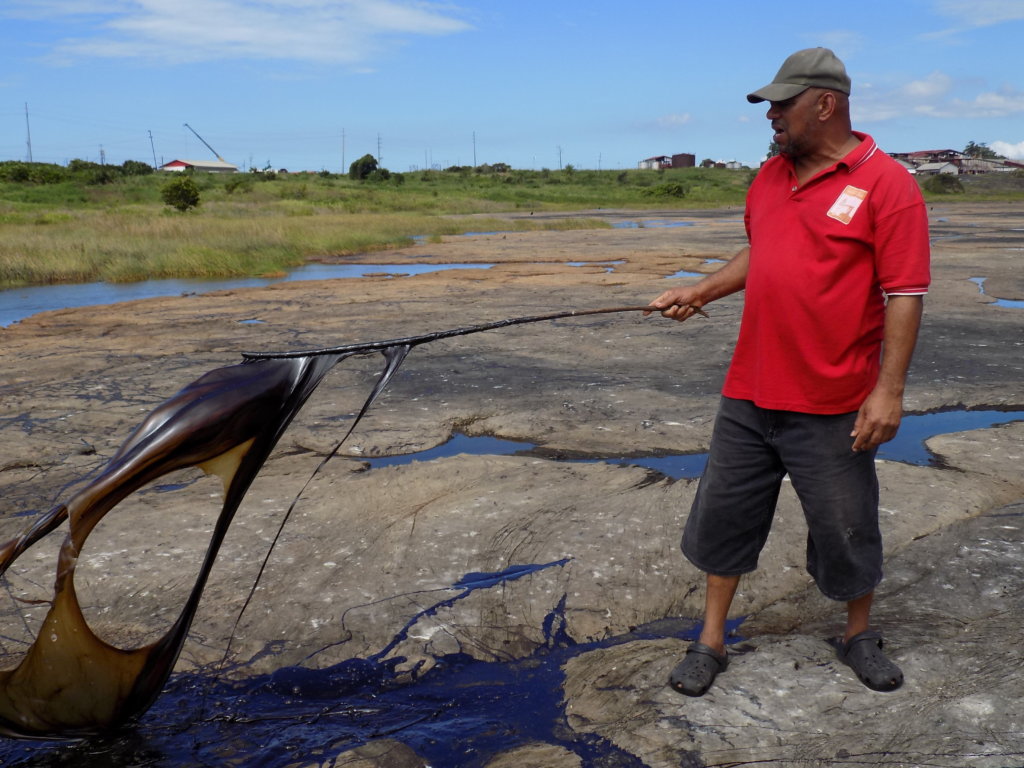
Spend a Couple of Days in Port of Spain
Trinidad’s capital, Port of Spain is not the most attractive city, but it’s vibrant with a lively music scene, some great food and fascinating history. There is more than enough to detain you for a couple of days.
Read my full guide on what to do in Port of Spain here.
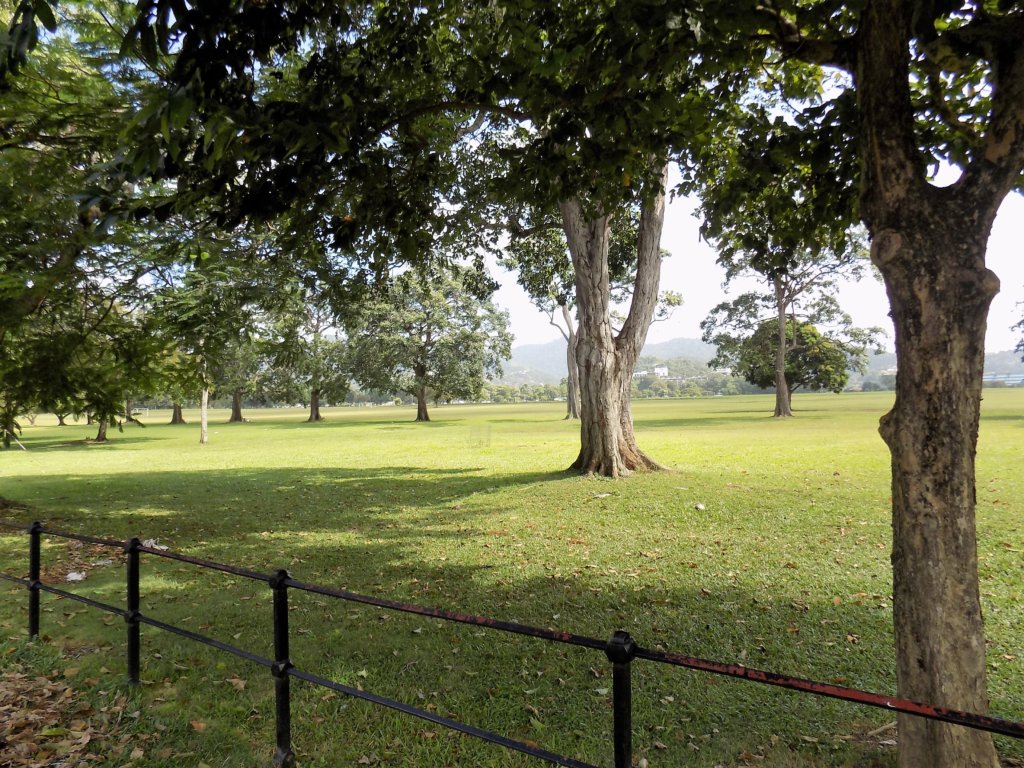
Go ‘Down the Islands’
The Bocas is a group of rocky islets separated from mainland Trinidad, and from one another, by the Bocas del Dragon (Dragon’s Mouth), a series of channels connecting the Gulf of Paria with the Caribbean. A very popular local outing is to take a boat trip ‘down the islands’ from Chaguaramas marina. Unfortunately, we ran out of time to do this, but it is firmly at the top of the list for the next time we’re in Trini!
Dolphins frequent the waters between the islands, as do leatherback turtles and pilot whales. You may get lucky and spot all three.
In the eighteenth century, the Bocas had a thriving whaling industry with whaling stations on the three main islands of Gaspar Grande, Monos and Chacahacare. Today, the islands are sparsely inhabited, with no roads and dense forest covering the interiors and hiding the few holiday homes that have been built on them. They are only accessible by boat. Few trips actually land on the islands, preferring instead to drop anchor in the bays for an afternoon of eating, drinking and swimming.
The first island you pass when heading down the Bocas chain is the small rocky Carrera, Trinidad’s equivalent of Alcatraz. A prison was built on the island in 1876 and convicts still do hard labour there.
If you go on a trip organised by the Chaguaramas Development Authority (CDA), you may be able to land on the most accessible island, Gaspar Grande, and visit the eerie Gasparee Caves. Once used by pirates to hide their booty, the caves are now home to colonies of fruit bats. There are impressive stalactites and stalagmites in the cathedral-like, 35 metre deep, main cavern and a deep clear turquoise tidal pool you can swim in.
The furthest island from the mainland is Chacachacare, an hour’s boat ride away. This former leper colony is the largest island in the Bocas and has a number of lovely beaches with pale golden sand and shallow, calm, crystal-clear water. You are free to explore the derelict structures of the leper colony and imagine what life must have been like for patients who lived there. Established in 1887, it was run on prison lines by a group of Dominican nuns. Incredibly, it was in use until 1984, when the last 30 patients were transferred elsewhere!
Relax on the Beach at Maracas Bay
Unlike most Caribbean islands, Trinidad is not known for its tropical beaches. However, there are exceptions and Maracas Bay is one of them. There is a wide expanse of golden sand with sunbeds and umbrellas available to hire. A number of beach bars offer drinks and typical Trini street food including shark ‘n’ bake and doubles.
At one end of the bay, local fishermen mend their nets and land their catch. They are happy to chat to you about their lives and how they make their living.
You can reach Maracas Bay via Trinidad’s famous north coast road.
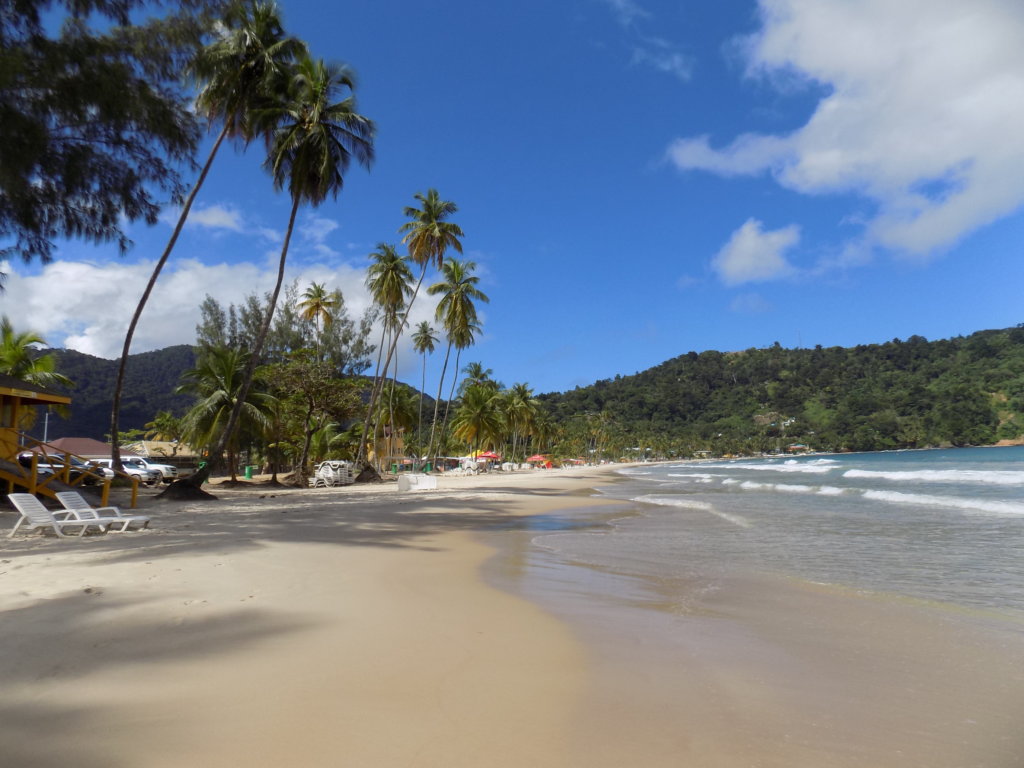
Hire a Car to Explore the Island
If you are not taking a tour, the best way to explore Trinidad is to hire a car and drive yourself. There are several car rental companies located at Port of Spain’s international airport. Several of them accept advance bookings online.
As I explained in this post, many of Trinidad’s roads are in a terrible state of disrepair so you will need to keep your wits about you at all times, but the rewards are worth it. You can drive along the east coast, explore Trinidad’s north-west corner, and visit some less well-known attractions such as the Waterloo Temple in the Sea.
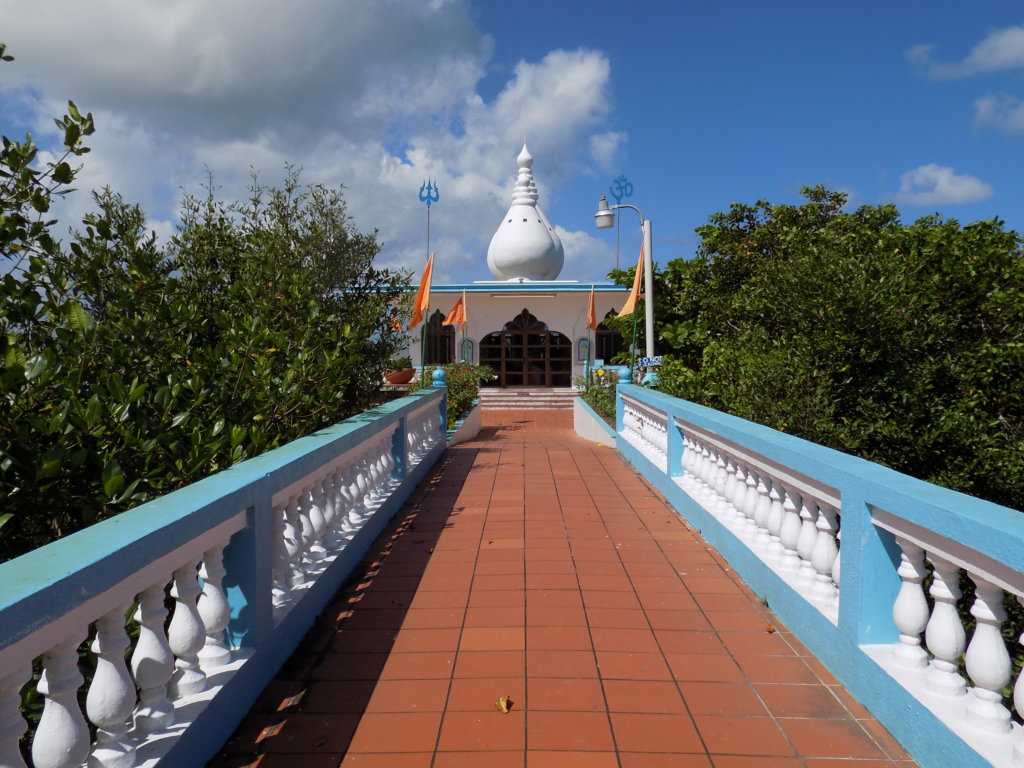
Learn about Hummingbirds
One of the highlights of our trip to Trinidad was learning all about hummingbirds. Several species of these fascinating creatures are native to Trinidad and Tobago. They are valued by the locals, not least because the Amerindians, the original inhabitants of the islands, believed that hummingbirds contained the souls of their ancestors. Hummingbirds are the major pollinators in Trinidad and Tobago, pollinating over 8000 species of flowering plants. The hummingbird is on the national coat of arms, the currency, and the passport. It is the symbol of Caribbean Airlines and the country’s post office.
Whether or not you are a twitcher, I urge you not to leave Trinidad without visiting both the Asa Wright Nature Centre and Yerette. In the former, you will be able to observe hummingbirds feeding and go on a guided nature trail to learn all about Trinidad’s flora and birdlife. At Yerette, you will be royally entertained by Theo and Gloria Ferguson. Gloria will prepare a simple but delicious lunch for you and Theo will have you enthralled by his encyclopedic knowledge of hummingbirds and his stunning photos of them. In their gloriously floral garden, you will get up close and personal with these incredible birds and marvel at their behaviour as you try to capture shots which would adequately convey their beauty.
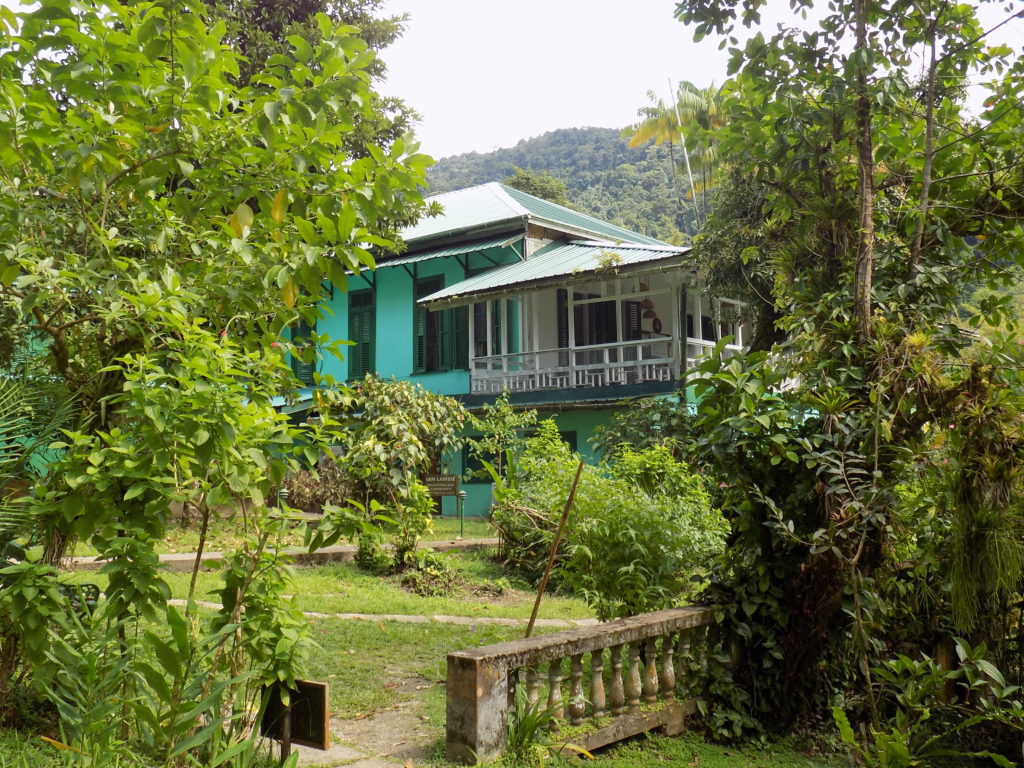
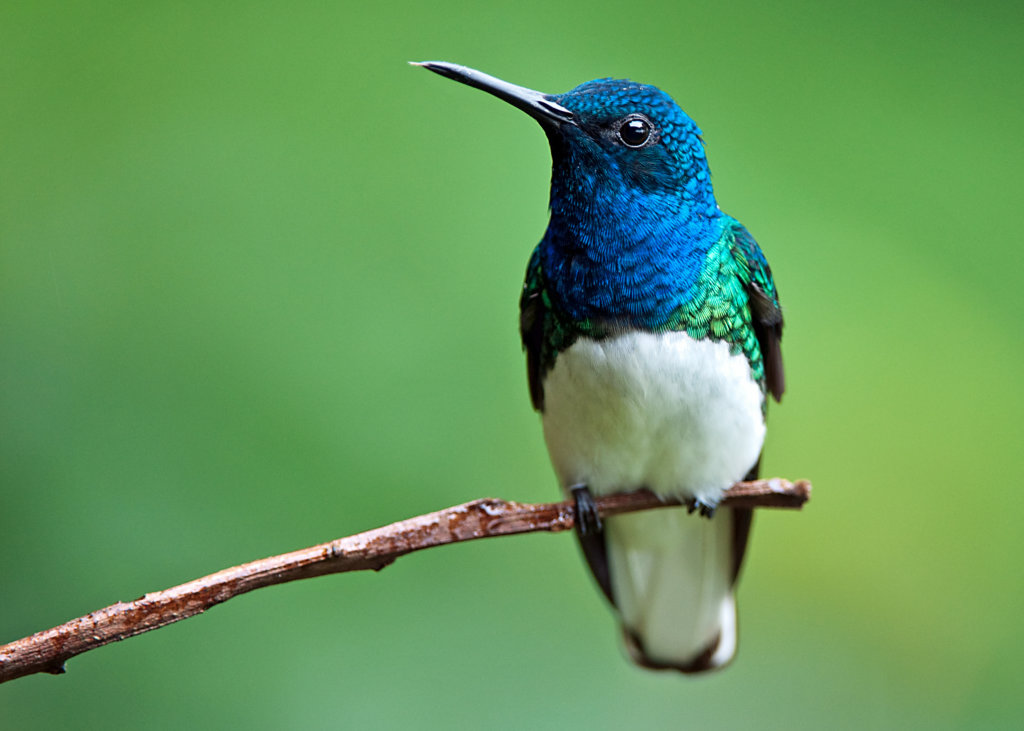
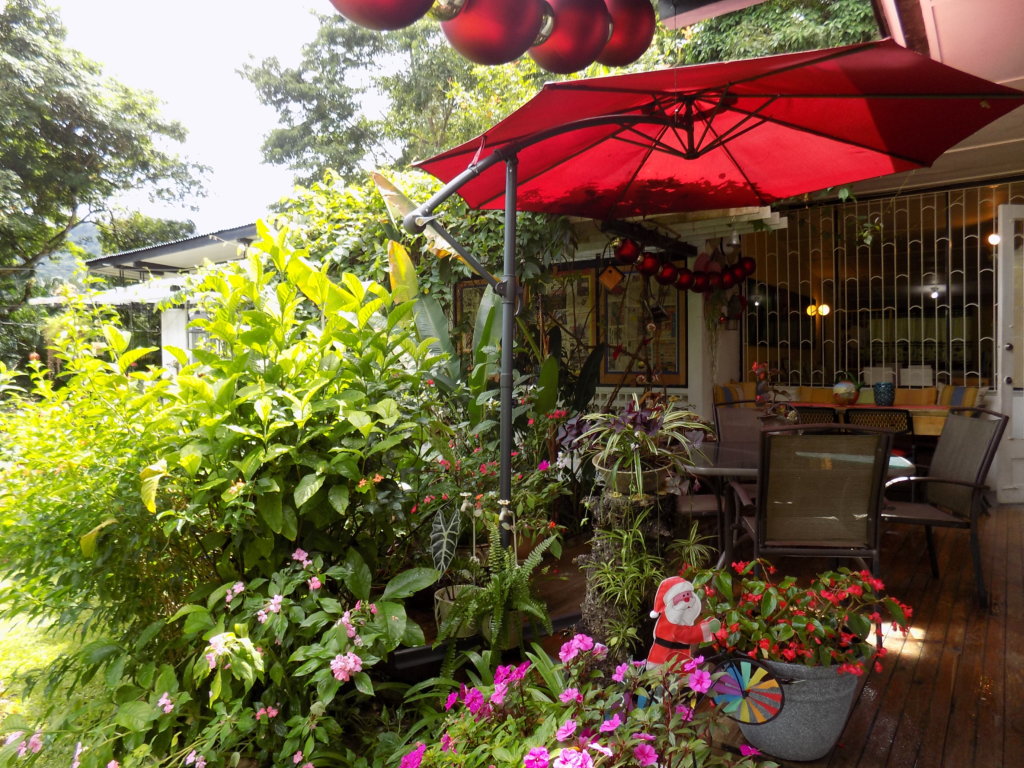
Visit Pointe-a-Pierre Wildfowl Trust
Another must-see destination on Trinidad is the Pointe-a-Pierre Wildfowl Trust located, incongruously, in the grounds of the Petrotrin Oil and Gas Company! This verdant oasis is a conservationist’s dream. The breeding programme being run here is the most successful in the Caribbean and the trust’s education project, in conjunction with local schools, goes from strength to strength.
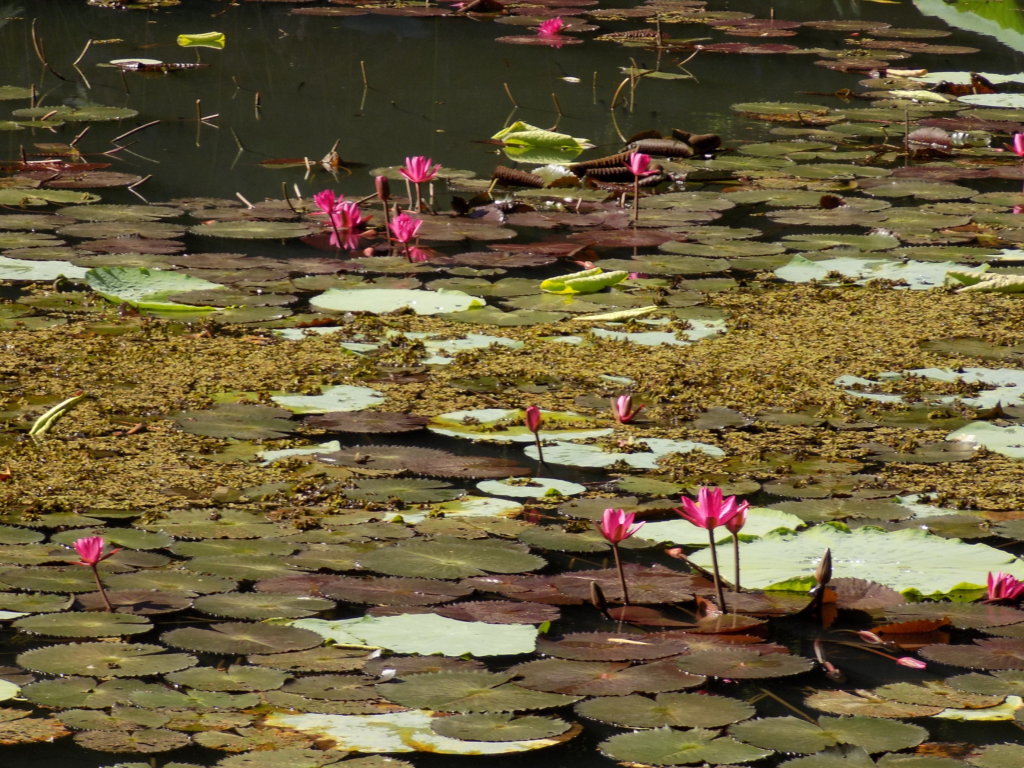
Experience Carnival
If you’re lucky enough to be in Trinidad during carnival time, you’re in for a treat!! The focus of the festivities is in Port of Spain with the main carnival parades taking place on the Monday and Tuesday before the start of Lent. The build-up, however, happens for several weeks before with competitions to find the best calypso, soca, and steel pan bands. The culmination of all of the celebrations is the Carnival Tuesday Parade of the Bands with the full display of elaborate costumes that people have been working on for months. It surely is a sight to behold!!
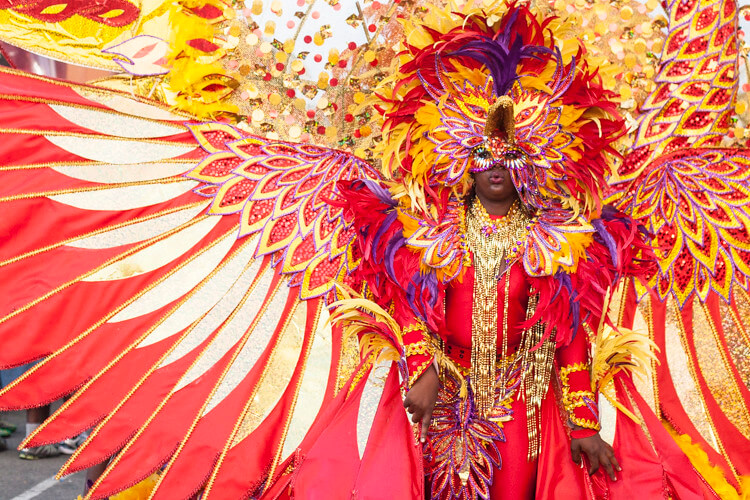
Take a Tour
Whilst it’s perfectly possible to explore Trinidad independently, why not join a tour and let someone else sort out the logistics? It’s a great idea, especially if time is limited. Whenever we visit a new destination, we book a tour with a local guide. There’s no better way to get under the skin of a place! We use Viator when we want to uncover interesting things to do in a new country. They’re easy to use and book with, and we’ve had some amazing experiences with them.
Check out these options:
Read more about Trinidad and its birdlife
If you like what you’ve read, PIN IT!!
If you’re travelling soon, please use these links!
Are you travelling soon? Use these links when making your bookings. These are the companies we use. It won’t cost you any extra, but we will earn a few pennies to help keep Happy Days Travel Blog going. Thank you!!
- Book your travel insurance with World Nomads (Never leave home without protecting yourself, your trip and your belongings!)
- Book your flight with Skyscanner
- Book your accommodation with Booking.com
- Book a tour with Tour Radar or Intrepid Travel
- Book city tours and activities with Get Your Guide
Disclosure: This post contains affiliate links. If you click through for more information, or to make a purchase, it may result in a small commission coming my way. Please note that there is no extra cost to you associated with this. Thank you so much for supporting my site.
Join our mailing list

Sign up to receive our monthly newsletter. Keep up with what we're doing and be the first to receive special offers and insider tips.

